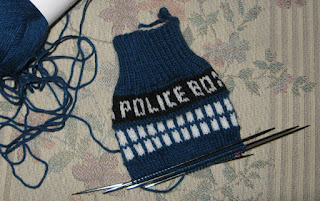This is the sock pattern from The Knitting Teacher’s
Assistant Designed for the Use of the National Girls’ School, printed in 1817.
The facsimile edition is available from Robin Stokes (www.robinstokes.com) Information about the historical
content of the original book and pattern elements may be found in my post about the pattern for and
knitting of the stockings (http://historyknits.blogspot.com/2011/06/stockings-from-1817.html)
The pattern is also available from Chris Laning, aka
Claning, using modern knitting terminology, on Ravelry at http://www.ravelry.com/patterns/library/school-sock-from-1817
I followed her pattern so as to be able to enter this pair of socks into the
Ravelry project’s database. I did, however, make a few changes, noted below.
A third version of this pattern can be found at http://pdf.library.soton.ac.uk/WSA_open_access/00376329.pdf There are, however, some differences in this reprint of 1881 and I shall be discussing them when I post about the sock or stocking made from that edition. My thanks to SusanA of the Ladies Work-Table Yahoo Group for posting that Link.
A third version of this pattern can be found at http://pdf.library.soton.ac.uk/WSA_open_access/00376329.pdf There are, however, some differences in this reprint of 1881 and I shall be discussing them when I post about the sock or stocking made from that edition. My thanks to SusanA of the Ladies Work-Table Yahoo Group for posting that Link.
In keeping with the times, there
was no tension/gauge or needle size stated in the original pattern. Clanning’s
pattern did have a gauge which worked out for me at size 2mm/US 0 needles. The sock wool, Paton’s Kroy
Socks 4 Ply in Flax, which knits up as a brownish-grey,
is also finer than the Harrisville Shetland that I used for the stockings and,
consequently, larger needles, too.
The first row is knit straight
which happens to be something I do with every piece of knitting no matter what
the instructions as it is the only way I will ever create a smooth edge. This
was followed by the original 3/3 ribbing in 12 rows (not six as for the
stocking), as in the original pattern for socks.
The three things I like best
about this pattern are the alternate knit/purl seam stitch which is continued,
decoratively, on the sides of the instep to the toe, the picking up/increasing
of stitches in the instep and the different numerical sequences in the
decreases of the toe. I, unfortunately, was distracted by 22 men playing in the
Euro 2012 when I got to the toe of the first sock and completely forgot about
that charming sequence, and did the regular every other row decrease on
automatic pilot. The second sock had to follow suit.
I also departed from the past by
adding Lang Yarns Jawoll Reinforcement Thread, which does contain wool,
to the heels and toes. I reinforce all of my socks either with this kind of
yarn or doubling the sock yarn.









